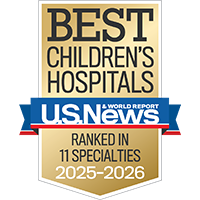Smell the roses
Wander outside into our Butterfly Garden in Oakland and our healing gardens at Mission Bay.


Congenital diaphragmatic hernia, or CDH, is a condition that develops before birth. Babies with CDH have a hole in their diaphragm, the wide, flat muscle that separates the chest from the abdominal cavity. Normally, the diaphragm forms during the 6th through the 12th week of pregnancy. If the diaphragm doesn't form completely, CDH occurs. Most often, the defect is on the left side. CDH affects about one in every 2,500 births.
The hole in the diaphragm allows the contents of the abdomen — which may include the stomach, intestine, liver, spleen or kidney — to herniate up into the chest. These abdominal organs occupy space in the chest and prevent the lungs from growing to normal size. The growth of both lungs can be affected. This is called pulmonary hypoplasia. While in the uterus, a fetus doesn't need lungs because oxygen is delivered through the mother's placenta. Once the baby is born, healthy lungs are necessary.
There is a wide range in the severity of CDH. In the best cases, some infants do very well with neonatal care and surgical treatment after birth. On the other end of the spectrum, babies with severe CDH will have a difficult struggle after birth, and some will not survive. Even when the CDH is severe, however, more than 70 percent of affected babies can be saved with intensive support. Some may be candidates for prenatal intervention. The UCSF Fetal Treatment Center was the first facility in the world to offer treatment for congenital diaphragmatic hernia while a baby is still in the womb.
Experts at the UCSF Fetal Treatment Center have compiled a free patient guide book about CDH. The book is available for download on iPads with iBooks 2 or on computers with iTunes. To download, visit iTunes.
To request an appointment, call the Fetal Treatment Center.
CDH is typically diagnosed before birth during routine screening tests. An ultrasound may show abdominal contents in the chest cavity.
After birth, symptoms of congenital diaphragmatic hernia may include:
CDH is usually diagnosed before birth during routine screening tests. After the initial diagnosis, it is important to have an expert assess your fetus to determine the severity of the defect. Knowing the severity is important for determining the best treatment options.
The two factors used to grade the severity of CDH are the position of the liver and the lung-to-head ratio. Liver position refers to whether or not any portion of the liver has herniated, or moved up into the chest. Fetuses with a portion of the liver in the chest have a more severe condition.
The lung-to-head ratio is a numeric estimate of the size of the lungs based on measuring the amount of visible lung. High lung-to-head ratios are associated with good outcomes.
Fetuses on the most severe end of the spectrum, with liver up into the chest and a lung-to-head ratio less than 1.0, may be candidates for prenatal intervention.
There is a wide range of severity and outcomes for CDH. In the best cases, some infants do very well with routine neonatal care and surgical treatment after birth. Even though the lung isn't of normal size at birth, it has the capacity to grow and adapt for many years, so these children can lead normal, active lives without restriction.
On the other end of the spectrum, babies with severe CDH and very small lungs are guaranteed to have a difficult struggle after birth, and some will not survive. Even when the CDH is severe, however, more than 70 percent of affected babies can be saved with intensive support. However, there are often long-term health issues related to breathing, feeding, growth, hearing and development.
Most babies with CDH fall somewhere in between these extreme ends of the spectrum.
Most fetuses with CDH require some level of prenatal monitoring. Care must be taken when choosing where to deliver the baby. Families will want to work out a plan for delivery and postnatal care with their obstetrician or perinatologist, the neonatologist and pediatric surgeons, so the baby can be stabilized and treated in the same center.
Babies with less severe CDH do not require special prenatal management in terms of the timing or type of delivery, but should be delivered in a perinatal center with a Level III intensive care nursery with experienced neonatologists and pediatric surgeons. The place of delivery is very important because transporting these babies after birth can be dangerous for the infant. Most babies will be in the intensive care nursery for several weeks.
Babies with severe CDH need very skilled intensive care: high-frequency oscillatory ventilation, inhaled nitric oxide and, in some cases, extracorporeal membrane oxygenation (ECMO). ECMO provides temporary support for lung failure by circulating the baby's blood through a heart-lung machine. It can be life-saving, but can be used for only limited amounts of time before complications become excessive. These babies must be delivered in a very experienced tertiary perinatal center with ECMO capability.
The surgery to repair CDH after birth is usually performed after the baby has stabilized in the first week of life. After repair, these babies will need intensive support for many weeks or even months.
The surgeon will evaluate the severity and exact location of the hernia during the operation. Based on these findings, the hernia will be repaired in one of three ways.
If the opening in the diaphragm is small and there is enough diaphragmatic muscle, the hole can be sewn closed. This is called a primary repair. If the opening is large or a significant portion of the diaphragm is absent, the surgeon will use additional tissue or material to close the defect. Often, a synthetic biocompatible material will be used to patch the opening. This is called a patch repair. In some patients, the surgeon will close the hole in the diaphragm with a flap of muscle from the infant's abdomen or back. This is called a muscle flap repair.
In select circumstances, infants may be a candidate for a minimally invasive thoracoscopic repair. The surgeon will determine the type of repair required and the material to be used at the time of the operation.
We recommend seeing your child's pediatrician within one week of leaving the hospital.
Once your child is home, we wish to closely monitor your child's progress in our outpatient follow-up program for children with CDH, called the LIFE Program. Our specialists have specific expertise in providing continued long-term care for children with CDH. Team members include experts in pediatric surgery, neonatology, pulmonology, nutrition, developmental pediatrics, gastroenterology, social services and nursing. Before your child is discharged from the hospital, we will make an appointment for your child's first visit to the LIFE Program.
Some children will need another operation or operations later on, to repair a recurrence of the CDH. Often this is related to the severity of the CDH at birth, and whether or not a synthetic patch was needed to close the hole in the diaphragm. In our experience, recurrence is less common for children with a primary repair and more common in children who had a patch repair. The patch may pull away from the chest wall as the child grows, causing a recurrence.
The symptoms of a recurrence include retching, gagging and vomiting feedings, pain or rapid breathing. Some children will have no symptoms. If you suspect a recurrence, take your child to the emergency room and explain your child's history and your suspicions to the emergency room team. You and the emergency room physicians can contact our surgeons at any time.
UCSF Benioff Children's Hospitals medical specialists have reviewed this information. It is for educational purposes only and is not intended to replace the advice of your child's doctor or other health care provider. We encourage you to discuss any questions or concerns you may have with your child's provider.


Top 10 in the nation for neonatology

Ranked among the nation's best in 11 specialties

successful open fetal surgery in the world

in number of fetal surgery clinical trials
Smell the roses
